This is how we profile Oslo!
Edited on
19 March 2015VisitOSLO solves various problems for visitor-dependent enterprises in Oslo, and one of our tasks is to promote Oslo internationally. Profiling a city is a concept to which many have difficulty relating. What does it involve? I have dedicated this blog article to explaining some of the things we do to get Norway etched into the retina of people at large. Consequently, this is not the be all and end all of what we do, but examples of the activities we initiate to profile our city.
Blog by Katrine Mosfjeld – VisitOSLO (November 2014)
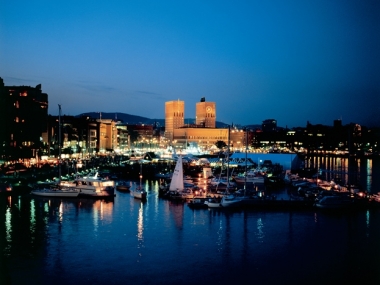
Strategic approach
People surround themselves with screens, day-in, day-out – in bed, in the bathroom, at work, while commuting, etc., etc. Based on this, we have taken as a starting point what we call “Oslo’s digital footprint” in our discussions about how we can influence people’s impressions of Oslo – or that people have an idea of Oslo at all. In our strategy, therefore, we have said that we believe we can best solve the problem by “conquering as many screens as possible” with stories or reports in which Oslo plays a key role. Who sends the reports is not so important, but it is clear that the message of Oslo’s excellence is ever stronger when others tell the story for us.
This is a situation we’re all familiar with! By expanding Oslo’s digital footprint, we aim to ensure that Oslo pops up on as many of these screens as possible. 
3 main categories of content will profile Oslo – and this is the basis of “Oslo’s digital footprint”:
1. Exposure of our own content
2. Turning followers into ambassadors
3. Stories about Oslo told by others
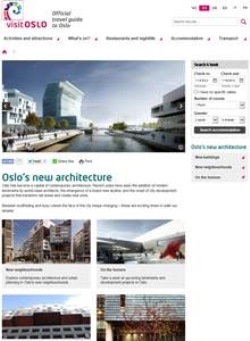 Screenshots from the new architecture section at visitoslo.com
Screenshots from the new architecture section at visitoslo.com
1. Exposure of our own content
The first category involves exposure of content we produce in-house for our own website or other channels. A good example of this is the new section at visitoslo.com that deals with architecture in Oslo. The section is in 6 languages, and tells the story about that noteworthy contemporary architecture that characterises the city today, with new buildings and new districts. Here, we also report about future developments, such as a new Munch museum, new library in Bjørvika, etc.
We also produce content that we allow others to publish on other channels, which is now even simpler through our open API. In this way, for example, Nettavisen has a good section on its website about Oslo and what’s happening in the city. We also have a set of videos that anyone can use on their channels to strengthen their reports about Oslo visually.
2. Turning followers into ambassadors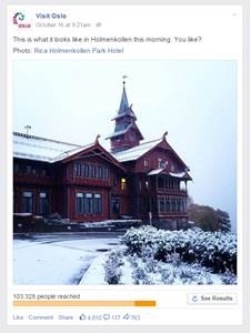
We use content to encourage involvement in our “own” social media. When we manage to engage our followers, Oslo is well profiled.
The second category of content with which we are working to expand Oslo’s digital footprint is the content we publish via our own social media channels. Sometimes we produce our own content for sharing, other times we ask for permission from others to use content they have produced, as you can see here in this example. Such content must always tell a good story about Oslo, and the aim of this content is to engage our followers in our content, so that their networks are exposed to this content (= these stories) about Oslo. We thus conquer new screens with credible stories – and our Oslo takes up a bit more space in people’s consciousness.
3. Stories about Oslo told by others
The third category of content we are working with is content created by others. This may be something as simple (and effective!) as messages sent via Twitter or images via Instagram, or it could involve larger content in the form of blog articles, journalistic content or videos posted on YouTube. This, of course, is the most demanding part of content production and the profiling work, as we have no say in the type of content produced or how much. In this respect, therefore, it is our job to pave the way for content production, and work with incentives for content production. And it works! In January this year alone we arranged for 715 press representatives to visit Oslo, who produced content for 485 international media outlets. We have often done this in close cooperation with Innovation Norway, and this cooperation has so far resulted in hundreds of articles, both online and offline (you can enjoy reading some of them here). And, of course, it is all good profiling of Oslo as both a tourist destination and a place to live, when media representatives who visit our city produce these types of articles about Oslo:
El Paìs / BBC News / The Guardian / New York Times / National Geographic.com.es and recently published Financial Times – How to spend it
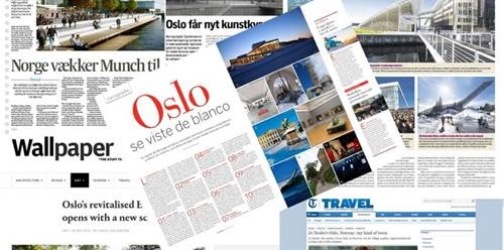
Effective arrangement of press visits gives Oslo headlines in the international press, both online and offline. This is good profiling of our city.
And as a matter of interest, I can also mention that from time to time, when we find a good blog article, we boost the number of hits and enable more readers to enjoy the rich content, even though we have not been involved in the article’s production.
We also endeavour to achieve increased production of good Oslo content in other social media. Through, for example, the #diggeroslo initiative, which basically urges Oslowegians to share their favourite images of Oslo with their social media networks, we are able to stimulate others to tell their stories about Oslo. At the time of writing, there are 11,043 images on Instagram with this hashtag, and we have thus succeeded in activating Oslowegians as local patriots and content producers. In the same way, we have endeavoured to activate visitor-based enterprise and visitors to Oslo to share their Oslo stories on Instagram under our own hashtag #visitoslo, among other things by making the images visible on Tripadvisor, the world’s largest travel portal. My search just now showed 87,502 images tagged with #visitoslo on Instagram. It is a staggering gallery of inspiration of people’s stories of Oslo told through their own photographs. And VisitOSLO has provided the opportunity. That is good profiling of Oslo!

A small selection of more than 11,000 images on Instagram with the hashtag #diggeroslo. The photographs profile, inspire and engage people in our city.
These are just a few examples of how we at VisitOSLO work to promote Oslo internationally. We work tirelessly to draw attention to and create a positive image of Oslo, so that the city is at the top of the list of places people want to visit, and preferably encourage people in all corners of the world to visit Oslo and experience as much of what the city has to offer.
Do you have any ideas about how to profile Oslo internationally? We are continually on the lookout for ways to develop our activities and methods, and would love to hear your ideas. Feel free to use the comment field in this blog or contact us through other channels.
Katrine Mosfjeld – VisitOSLO
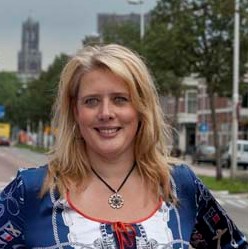 Submitted by mkruijf on
Submitted by mkruijf on
